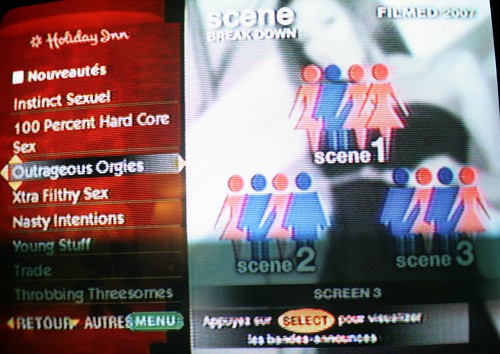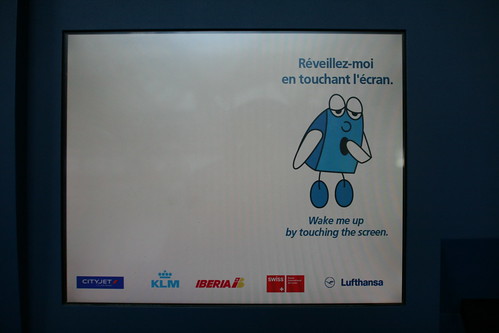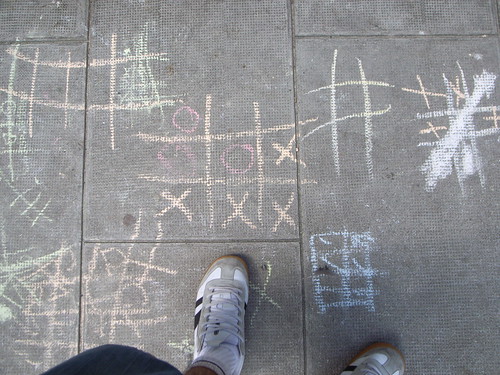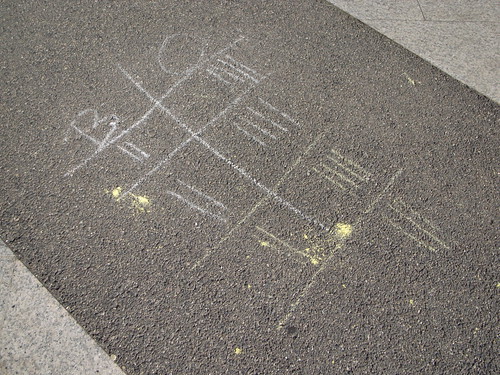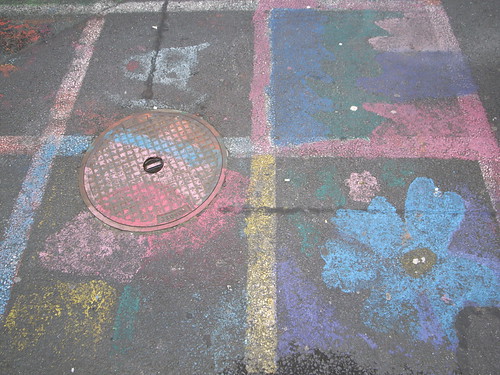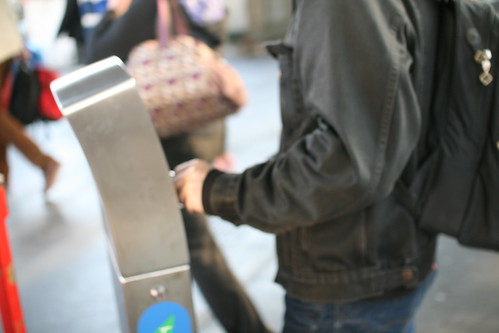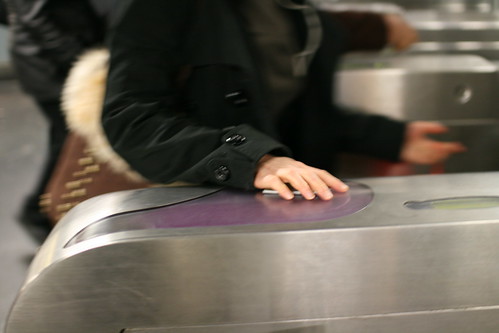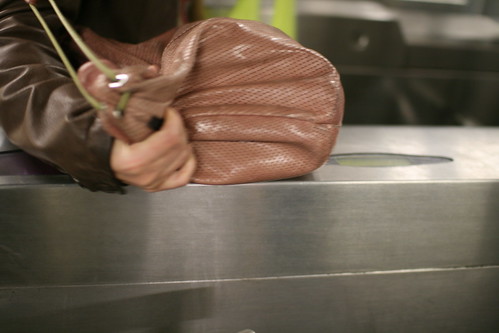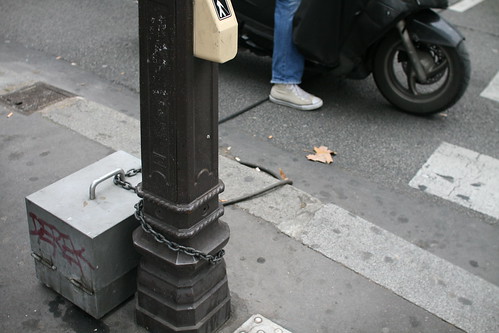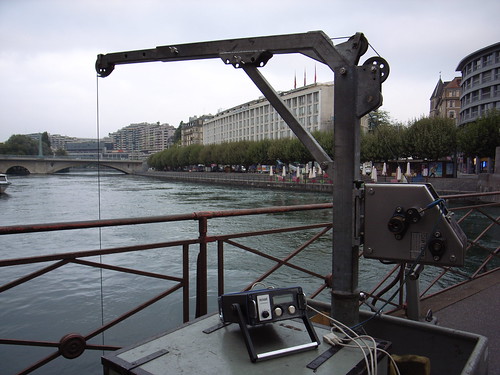wake me up by touching the screen
Weird toast, apophenia and what makes a thing a thing
 This well-known internet meme of Jesus or Mary on a toast struck me as particularly relevant while reading Brains in a vat by Hilary Putnam:
This well-known internet meme of Jesus or Mary on a toast struck me as particularly relevant while reading Brains in a vat by Hilary Putnam:
"An ant is crawling on a patch of sand. As it crawls, it traces a line in the sand. By pure chance the line that it traces curves and recrosses itself in such a way that it ends up looking like a recognizable caricature of Winston Churchill. Has the ant traced a picture of Winston Churchill, a picture that depicts Churchill? Most people would say, on a little reflection, that it has not. The ant, after all, has never seen Churchill, Or even a picture of Churchill, arid it had no intention of depicting Churchill. It simply traced a line (and even that was unintentional), a line that we can 'see as' a picture of Churchill. (...) We can express this by saying that the line is not 'in itself' a representation1 of anything rather than anything else. Similarity (of a certain very complicated sort) to the features of Winston Churchill is not sufficient to make something represent or refer to Churchill. Nor is it necessary (...) So it may seem that what is necessary for representation, or what is mainly necessary for representation, is intention.
Why do I blog this? reading pdf scattered on my desktop at the airport, waiting for my flight to Montreal, always a good time to think about such abstract matters. That topic, related to apophenia is always intriguing to nail down.
Sidewalk playground
 Different occurrences of sidewalk employed as a game platform, from European cities (Geneva, Lyon, Paris, Rotterdam)
Different occurrences of sidewalk employed as a game platform, from European cities (Geneva, Lyon, Paris, Rotterdam)
Quite a typology we have here with hop-scotch, tic-tac-toe, table to count point in whatever game, etc. What I've put here are only games that use the surface, for the use of shape, see this blogpost about skateboarding structures.
Surely a recommendation to have a look at what is under your foot in contemporary cities. And definitely of interest for people interested in urban computing? Why, simply to show how space is appropriated by a certain class of users and how simple they employ basic tools to create a playful environment. In the examples I chose here, there's only one instance where the sidewalk structure has been designed with a game purpose (the first one, in Rotterdam), there is room for both designed surface and people's appropriation. What role technology can play in this? perhaps mobile, touch and communication technologies can enable to expand the chalks, which seem to be the main tool used so far.
Things disclose a world, also when they break
In "What Things Do: Philosophical Reflections on Technology, Agency, And Design", Peter-Paul Verbeek writes that:
"Things, in short, disclose a world. (...) But that this is so, according to Heidegger, generally appears only when a handy or ready to hand tool or piece of equipment breaks down. When this happens, the tool suddenly demands attention for itself. The reliable dealings we are used to having with the tool are ruptured, and instead of withdrawing from our attention the tool suddenly forces itself upon us. Someone sits at a word processor focused on the text at hand and all of a sudden the computer freezes. The trustworthy world that developed around the computer – the open book, the keyboard, the screen, the cup of coffee; in short, the entire mutually referring network that Heidegger calls a world – is abruptly destroyed. The computer changes from being one of the handy or ready-to-hand that shape this world to what Heidegger calls something vorhanden: ‘objectively present’ in the newer translation, or ‘present-at-hand’ in the older. Its transparency is transformed into opacity. (...) Only when it starts up again and everything works without a hitch is the world that was destroyed again restored."
Why do I blog this? accumulating notes and insights about issues regarding people's experience of infrastructure for a project about electricity and the internet of things. The topic of breakings and failures is of course a long-time favorite, somehow linked to my fascination towards breakdowns. Beyond this, what I find important here is how to take that sort of unexpected issue into account in the design process, as well as investigating the range of people's reaction. Having a sort of typology (failures reactions) can be a good start.
Location-based annotation
 An intriguing example of location-based annotation. This red brick inserted in the pavement on Rue de la République in Lyon (France) indicates that former french president Sadi Carnot had been assassinated here on June 25th, 1894. The sort of things that people want to replicate online, but it generally lacks the elegance of the "brick" as en urban element well inserted into its context.
An intriguing example of location-based annotation. This red brick inserted in the pavement on Rue de la République in Lyon (France) indicates that former french president Sadi Carnot had been assassinated here on June 25th, 1894. The sort of things that people want to replicate online, but it generally lacks the elegance of the "brick" as en urban element well inserted into its context.

What, How, Why automation
In What Should be Automated?, Matti Tedre discusses the fundamental flaw in the debate around automation. The question should not be "what should be automated?" but instead "How can one automate things efficiently and reliably?", which then shifted to "why things should be automated?":
"since the 1980s the focus in computing research has been gradually broadening from the machine and automation toward how and where computers are used, the actual activities of end users, and how end users collaborate and interact (...) Neither the theoretician's question "What can be efficiently automated?" nor the practitioner's question "How can processes be automated reliably and efficiently?" include, explicitly or implicitly, any questions about why processes should be automated at all, if it is desirable to automate things or to introduce new technologies, or who decides what will be automated."
Why do I blog this? preparing a presentation about failed futures, including some elements about the problems caused by "automation". The author of the paper argues that the shift from what to how/why lead computing researcher to a situation where they really have to pay attention to " the needs, wants, hopes, expectations, wishes, fears, concerns, and anxieties that people have regarding technology".
Some design choices for touch interfaces
avoid too much effort, unlike:
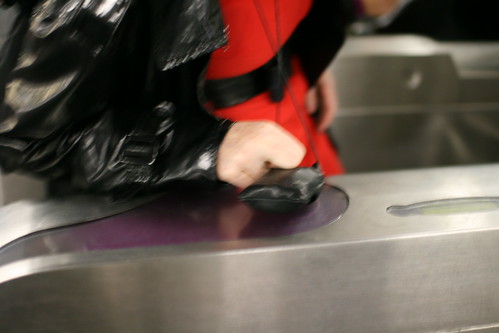
and, in the end, your aim should be that you reach what Adam calls "information processing dissolving in behavior":
(observed in Paris last week)
The city, being measured
Tesla on wireless electricity
 Being involved in a project about the Internet of Things and electricity consumption led me back to some stunning texts by Nikola Tesla, written back at the end of the 19th century.
Being involved in a project about the Internet of Things and electricity consumption led me back to some stunning texts by Nikola Tesla, written back at the end of the 19th century.
For instance, in "On Electricity",
"I wish much to tell you on this occasion—I may say I actually burn for desire of telling you—what electricity really is (...) But we shall not satisfy ourselves simply with improving steam and explosive engines or inventing new batteries; we have something much better to work for, a greater task to fulfill. We have to evolve means for obtaining energy from stores which are forever inexhaustible, to perfect methods which do not imply consumption and waste of any material whatever. (...) In fact, progress in this field has given me fresh hope that I shall see the fulfillment of one of my fondest dreams; namely, the transmission of power from station to station without the employment of any connecting wire. Still, whatever method of transmission be ultimately adopted, nearness to the source of power will remain an important advantage."
Also more to draw from World System of Wireless Transmission of Energy:
"The transmission of power without wires is not a theory or a mere possibility, as it appears to most people, but a fact demonstrated by me in experiments which have extended for years. Nor did the idea present itself to me all of a sudden, but was the result of a very slow and gradual development and a logical consequence of my investigations which were earnestly undertaken in 1893 when I gave the world the first outline of my system of broadcasting wireless energy for all purposes. (...) The transmitters have to be greatly improved and the receivers simplified and in the distribution of wireless energy for all purposes the precedent established by the telegraph, telephone and power companies must be followed, for while the means are different the service is of the same character. Technical invention is akin to architecture and the experts must in time come to the same conclusions I have reached long ago. Sooner or later my power system will have to be adopted in its entirety and so far as I am concerned it is as good as done. I"
Why do I blog this? of course Tesla's exhuberant (and ultra-positivist) claims are kind of weird today (although you can find them stated by lots of people) but what I find intriguing here is how his long-chased goal is still a research purpose lately. Some great lessons about the relationship between time and innovation. If your read his stuff, you can notice how the end of the 19th century was described and seen as an accelerating moment in time, where innovations was sparkling here and there "like never before".
Locative versus non locative social practices
In her short paper entitled Understanding Socio-locative Practices", Ingrid Erickson describes her research project, which aims at understanding the motivations behind and impacts of what she calls "new socio-locative practices: geotagging online photographs or microblogging using location-based presence cues. In particular, she focused on two recent social practices that have locative and non-locative components: photo sharing on Flickr (with and without geotags) and "broadcast microbloging" via Jaiku (locative) and Twitter (non-locative). Her objective is the following:
"to compare two sets of locative and non-locative practices to assess how, if at all, the introduction and use of locative information in social, digitally-mediated interactions is beginning to evoke new ways of relating among people and between individuals and place."
She then reports on a preliminary study she carried out, which aimed exploring the perceived difference between locative metadata attached to an object and to a person. To do so, she both interviewed industry representatives/researchers and users (experienced and non-experienced):
" Findings from the pilot study revealed that experienced subjects framed both practices as opportunities for broadcasting within a social context regardless of the prevailing rhetoric that normalized the use of social mapping applications primarily for finding others. "
She is now investigating the roles played by location in the broadcast practices of individuals within social interaction orders. She is contrasting the usage of Flickr between groups who use geotags and groups who don't, as well as comparing usages of Jaiku (locative) to Twitter (non-locative). Why do I blog this? Mauro and I approached that topic in our PhD research, although our research angle was more psychological than sociological. Look forward to read the results!
Wii-like consoles
Digging some material for a project about gestural interfaces in France lately, I stumbled across this sudden (and curious) surge of Wii-like platform, see for example these 3 devices:

First, the technigame, a very rouge game console which allows to play bowling/soccer/tennis with a stick that has "infraroufe" connectivity (the typo is funny). The game seems to be entirely ripped off from the Sega Master System reshuffled with manga-style characters in a very weird way. The name itself is also stunning.

Then you have this other "technigame" version sold at the lowcost shop "La foirfouille" for 39.99euros. it looks like a Wii although reshaped by people who misunderstood Karim Rashid's blobject concept.

Perhaps, the "Kiu" by Videojet is a tad more personality, with its own globular shape. The console only offers 5 built-in games.
Why do I blog this? It's always intriguing to look at product copies as they are generally curious attempts to re-appropriate ideas in a new way. From a more abstract POV, it also shows how certain people think the Zeitgeist is. What seems to be the value proposition here is clearly the price, ranging from 40 to 90 euros, cheaper than Nintendo's platform. However, the only thing these devices appears to bring to the user, apart from the nasty wii-ripped shape, is the use of gestural interaction (as if it was the only innovation on the Wii). Of course, in addition, the way these devices are advertised, using the family-tech momentum of the Wii, is revealing.
That said, I haven't tested these consoles (yet).
Overmodern in the present
Marc Augé on space and place issues regarding subway practices in this interview:
"JPC: The subtitle of Non-lieux is "An introduction to an anthropology of the overmodern." What can you say about this phrase?MA: The word "overmodern" is an attempt to suggest the logic of excess at work in our present-day modernity. There is first of all an excess of information, making us prisoners of the news--as if history had caught up with us in the form of news. Yesterday's news becomes history, already just barely perceptible. It ages even more rapidly than fashion, of which it is an accelerated form.
There is also an excess of space that paradoxically amounts to a shrinking of space: we now feel we live on a finite planet where all we can do is go around in circles. (Pascal's anguish is democratized, so to speak.)"
Why do I blog this? simply because this is one of the starting point for the Lift09 program. As Augé formulated, we're kind of stuck in present-prison, which made the future vanish as he also described in his latest book: "Où est passé l'avenir).
Where did the future go? Beyond robotic houses and 3d videophones, as well as deterministic mindset, are there any interesting changes under the glossy surface of iphone releases? That's what the Lift conference in 2009 will try to address.
Remediating both gramophone and photography with a tape recorder
 There is this moment in time when companies (after accounting computations and equation solving) release this sort of things and wonder about what sorts of added value it will have for people. The tape recorder was not primarily marketed as a music-playing device. It was meant to store memorable moments (babies), funny situations (snoring people? wet farts?), “voice letters” and the brave “sound hunting”. That's the topic Karin Bijsterveld tackle in her paper What Do I Do with My Tape Recorder …?’: sound hunting and the sounds of everyday Dutch life in the 1950s and 1960s (Historical Journal of Film, Radio and Television Vol. 24, No. 4, 2004).
There is this moment in time when companies (after accounting computations and equation solving) release this sort of things and wonder about what sorts of added value it will have for people. The tape recorder was not primarily marketed as a music-playing device. It was meant to store memorable moments (babies), funny situations (snoring people? wet farts?), “voice letters” and the brave “sound hunting”. That's the topic Karin Bijsterveld tackle in her paper What Do I Do with My Tape Recorder …?’: sound hunting and the sounds of everyday Dutch life in the 1950s and 1960s (Historical Journal of Film, Radio and Television Vol. 24, No. 4, 2004).
Above all the use case scenario envisioned by audio-tape designers and engineers, the "sound hunting" one is the most intriguing with all these weird photos with people bringing recorder here and there. There is an inherent poetry in this will to capture the sound of the environment. This hobby held for a while and is not a bit defunct; it's surely curious though as attested by this quote from a BASF ad campaign:
"Today’s hunters no longer turn to the woods or fields, but to the noisy big cities. Instead of banging rifles they take their silent tape recorders with them. These modern day hunters call themselves ‘sound hunters’. Instead of hunting for deer, foxes and rabbits, they are after sounds and noises. To be sure, sound hunting is no less exciting than hunting in the green fields"
The paper reports how companies came out with this "sound hunting" hobby as a way to engage people in the usage of their product:
"Apparently the recorder’s usefulness had to be established against all odds, for tape recorder books also highlighted, and exasperatingly so, that after a short period of great enthusiasm many people no longer knew what to do with their tape recorder. (...) other publications underlined that the tape recorder, unlike the gramophone or the radio or TV set, did not produce sounds automatically, but that this quality depended on the effort and creativity of the user and that therein was the secret of the satisfaction the device could give. (...) the enthusiasts and manufacturers of tape recorders tried to link up the tape recorder fad with hobbies and leisure activities that were already familiar: photography, writing letters, amateur music-playing, learning languages, tinkering, and even cooking, painting, reading and, increasingly so, music listening. (...) It is of course a common and often successful marketing ploy to link up a new technology with old and familiar practices "
Why do I blog this? I enjoy reading material about history of sciences/techniques lately as they always give interesting ideas or case studies regarding the user experience of technologies. In the present case, the tape recorder history seems to give an interesting instance of how a "new media often incorporate elements from the practice of older media". As we can realize now, the tape recorder tried to remediate both gramophone (recording and listening to music) and photography (through "sound hunting"). While the former remediation was a success, the latter only lasted few years and is now almost forgotten.
"i work in ubiquitous computing"
Often bemused by the "on the internet" versus "in the internet" debate, it's intriguing that the only person we can find who refers to "i work in ubiquitous computing" was late Mark Weiser (see on his website). A google query on "i work in ubiquitous computing" seems to confirm it.
Escape mechanism for location-based services
As stated by Roy Want and colleagues in 1993 in their paper that describes "The Active Badge Location System"
"there will always be some days when for whatever reason somebody does not wish to be located. The location system tracks badges and NOT people. Anybody wearing a badge can remove it and leave it on a desk. The Active Badge system will then be misled into locating that person in an area that has been chosen for this deception. This kind of escape mechanism is not an undesirable system feature and may be an important factor in making this system acceptable for common use. "
Spectrum range and human activities
 This colorful diagram depicts the allocations of frequencies of the electromagnetic spectrum in the US. It's stunning to see how revealing the comparison between different media/communication system and the spectrum range they "inhabit". For instance, blue is “tv broadcasting". Navigation is very present too.
This colorful diagram depicts the allocations of frequencies of the electromagnetic spectrum in the US. It's stunning to see how revealing the comparison between different media/communication system and the spectrum range they "inhabit". For instance, blue is “tv broadcasting". Navigation is very present too.
Why do I blog this? Lots of stuff to analyze with these inscription, it's intriguing to see what you can draw in terms of social organization (as well as assumptions about society) from technical diagrams like this. A nice exercise for the bored reader, try to find 3 hidden patterns about human activities in this representation.
On a more user-centric angle, see also “the bubbles of radio”.
The sociality of the play setting
In People, places, and play: player experience in a socio-spatial context, De Kort and Ijsselsteijn (Computers in Entertainment (CIE), 6(2), April/June 2008) discuss the "situatedness" of digital gaming. That is to say, the socio-spatial contingencies of the player experience. Of interest here is the exploration of how co-players or the audience, as well as the spatial context can shape the player experience:
"This social context cannot be described by the presence of others alone. It also encompasses the player’s ability to monitor other players’ actions, performance and emotions. It includes the other's role in this setting – acting or observing, competing, co-operating, or co-acting. And it comprises their opportunities for verbal and non-verbal communication. Together, the social affordances and the objective characteristics of the game and play context that contain them define the 'sociality' of the play setting. (...) The presence of others, or social presence, is seen here as a continuous dimension (as opposed to a dichotomous one) that varies based on the level of perceptual access to the real or virtual others, their communicative realism, and a shared behavioural engagement. "
Why do I blog this? I've always been intrigued by the role of audience/bystanders/co-located people in gaming situations, and of course of they influence the game experience. One of the topic I find intriguing is how game design can benefit from this and explicitly create interactions that would take advantage of the complexity of the social setting.
A matter of surface
User experience of potentiometer in gaming
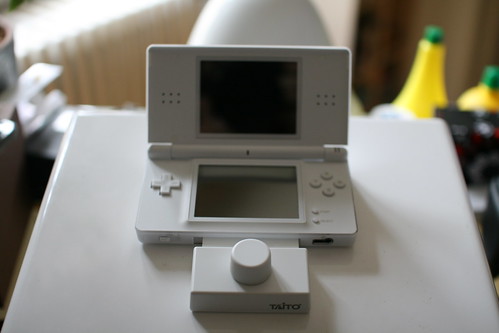 An interesting add-on for the Nintendo DS is this lovely potentiometer by Taito, somewhat reminiscent from paddle controller. Using a geared potentiometer actuation mechanism, the user experience is quite basic with brick-games such as Arkanoid. Rotating that sole button is intriguing and quite smooth. Of course some folks nailed it down more thoroughly and manage to control Mario Kart DS. Surely something to think about tangentially to this.
An interesting add-on for the Nintendo DS is this lovely potentiometer by Taito, somewhat reminiscent from paddle controller. Using a geared potentiometer actuation mechanism, the user experience is quite basic with brick-games such as Arkanoid. Rotating that sole button is intriguing and quite smooth. Of course some folks nailed it down more thoroughly and manage to control Mario Kart DS. Surely something to think about tangentially to this.
